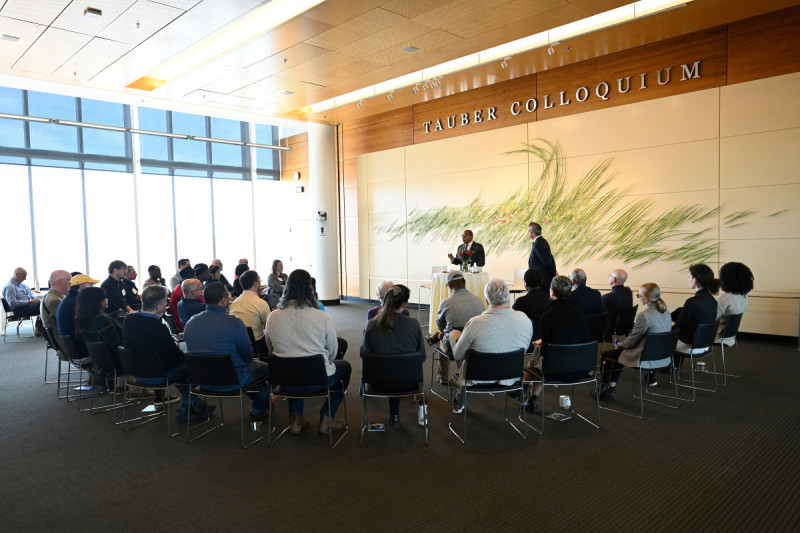Wynton Marsalis Joins Ross Design Jam About Business and the Arts

Wynton Marsalis at Ross School of Business
What do a world-famous jazz musician and a business school have in common? When it comes to the Ross School of Business and the +Impact Studio, far more than you might imagine! On Sunday, October 16th, the University Musical Society and the Ross School of Business +Impact Studio convened a one-day design jam at Michigan Ross to look at new ways of getting the arts into the hands of audiences through innovative uses of technology – using new tools and design methods to generate new formats and equitable access. This event was designed to coincide with a weeklong UMS residency with Wynton Marsalis and the Jazz at Lincoln Center Orchestra, and was sponsored by the William Davidson Foundation Director Discretionary Philanthropic Fund of the United Jewish Foundation.
Who better to headline a design event on new tools for equitable arts access than Wynton Marsalis? He is a trailblazer in leading, partnering with and supporting many culturally diverse performing artists; and the scope of his artistic outputs ranges across styles including classical, jazz and big band, and technical outputs like concert, film, dance, recordings and curation of older materials. His advocacy for the humanities and ties between education and communities played directly into this event’s partnership between the business school and Ann Arbor’s leading arts organization, UMS. Even the generative and improvisational thinking of the jam tied into Marsalis’s jazz background!
The design jam brought together an intimate group of artists, business leaders, techies, faculty, students, and arts lovers who combined their collective expertise to incubate new forms for reaching emerging audiences. The event featured a discussion with Mr. Marsalis to share his insights and concluded with attendance at a live UMS performance with Wynton and the Jazz at Lincoln Center Orchestra at Hill Auditorium. Marsalis shared his insights and thoughts on the interactions between the four pillars of society (religion, politics, business, and civics), which cemented the sacredness of the arts and the intersectionality of business and art. Mr. Marsalis also shared his 12 Principles of Business.
During the design jam, five teams of 5-6 individuals each and a facilitator independently worked on their own aspect of the core question, “How might we use new tools of organizing to create more equitable vehicles for artists to reach audiences and preserve what is sacred in the performing arts?” An admittedly broad statement, it generated many thoughts and ideas.
Teams worked with UM facilitators on several timed rounds of design thinking to generate and build on ideas and concepts. Techniques included context mapping, “I Wishes,” how-might-wes, dot voting, brainwriting, clustering, idea collision and vision storyboards.
Below are some examples of the table concepts generated:
- “How might we leverage a cross-medium approach to achieve benevolent creation and control (with serendipity) and maximize exposure and connection with audiences?”
- “How might we design an inclusive hybrid model that elevates and amplifies the artists’ compensation and art in both modalities?”
- “How might we empower audiences as changemakers that enable community immersion.”
- “How might we create incentives that provide artists with their basic needs and mobilize the public and private sectors?”
- “How might we make the arts more accessible to everyone in society?”
From these concepts, teams generated ideas to address them and ultimately imagined their potential solution within the context of vision storyboards. The work of the day concluded with a “gallery walk,” where teams could learn about other teams’ ideas.
The work of this intense design jam will be shared, including all of the design techniques and a special “How To” section, arriving in the near future. This site will provide inspiration for future efforts at connecting artists to audiences.
Source: Ross School of Business
